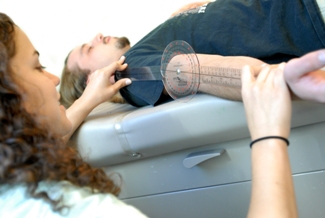

People with bleeding disorders, such as hemophilia and Von Willebrand Disease, may develop chronic joint disease from repeated bleeding into their joints. Over time, the joint disease results in decreased mobility of the joints. People without bleeding disorders also lose mobility in their joints with aging. However, there are very few studies of joint mobility over time in people without bleeding disorders.
Data from the joint range of motion study provide a baseline to learn more about loss of mobility due to joint bleeding.
To have a baseline with which to compare people with bleeding disorders, the joints of more than 600 people in the general population without bleeding disorders were measured as part of the study. From November 2003 to July 2006, CDC collected range of motion (ROM) measurements of the elbow, shoulder, hip, knee and ankle from a sample of individuals without known medical or physical conditions affecting the joint mobility.
The objective was to generate data that could be used to:
The following table provides the reference values along with 95% confidence intervals for normal range of motion for 11 measurements taken on 5 joints. Values are provided separately by sex and age.
Age 2–8
Females